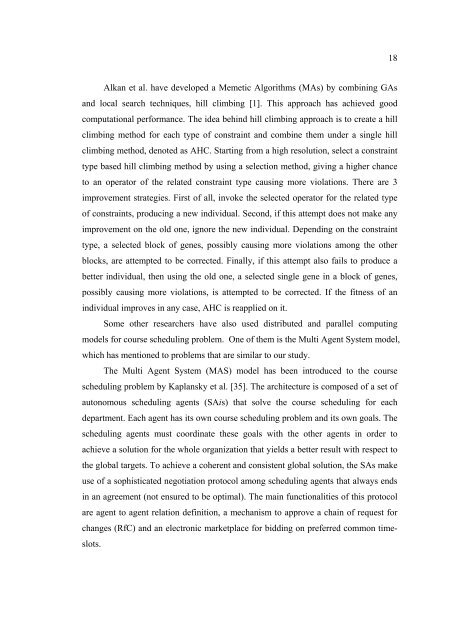a multi-objective bisexual reproduction genetic algorithm for ...
a multi-objective bisexual reproduction genetic algorithm for ...
a multi-objective bisexual reproduction genetic algorithm for ...
Create successful ePaper yourself
Turn your PDF publications into a flip-book with our unique Google optimized e-Paper software.
18<br />
Alkan et al. have developed a Memetic Algorithms (MAs) by combining GAs<br />
and local search techniques, hill climbing [1]. This approach has achieved good<br />
computational per<strong>for</strong>mance. The idea behind hill climbing approach is to create a hill<br />
climbing method <strong>for</strong> each type of constraint and combine them under a single hill<br />
climbing method, denoted as AHC. Starting from a high resolution, select a constraint<br />
type based hill climbing method by using a selection method, giving a higher chance<br />
to an operator of the related constraint type causing more violations. There are 3<br />
improvement strategies. First of all, invoke the selected operator <strong>for</strong> the related type<br />
of constraints, producing a new individual. Second, if this attempt does not make any<br />
improvement on the old one, ignore the new individual. Depending on the constraint<br />
type, a selected block of genes, possibly causing more violations among the other<br />
blocks, are attempted to be corrected. Finally, if this attempt also fails to produce a<br />
better individual, then using the old one, a selected single gene in a block of genes,<br />
possibly causing more violations, is attempted to be corrected. If the fitness of an<br />
individual improves in any case, AHC is reapplied on it.<br />
Some other researchers have also used distributed and parallel computing<br />
models <strong>for</strong> course scheduling problem. One of them is the Multi Agent System model,<br />
which has mentioned to problems that are similar to our study.<br />
The Multi Agent System (MAS) model has been introduced to the course<br />
scheduling problem by Kaplansky et al. [35]. The architecture is composed of a set of<br />
autonomous scheduling agents (SAis) that solve the course scheduling <strong>for</strong> each<br />
department. Each agent has its own course scheduling problem and its own goals. The<br />
scheduling agents must coordinate these goals with the other agents in order to<br />
achieve a solution <strong>for</strong> the whole organization that yields a better result with respect to<br />
the global targets. To achieve a coherent and consistent global solution, the SAs make<br />
use of a sophisticated negotiation protocol among scheduling agents that always ends<br />
in an agreement (not ensured to be optimal). The main functionalities of this protocol<br />
are agent to agent relation definition, a mechanism to approve a chain of request <strong>for</strong><br />
changes (RfC) and an electronic marketplace <strong>for</strong> bidding on preferred common timeslots.













